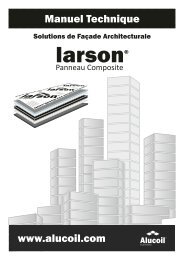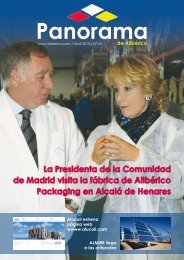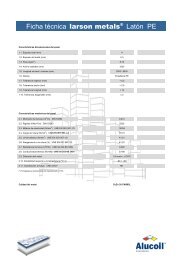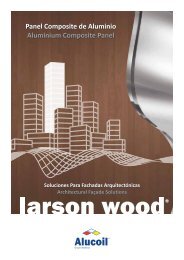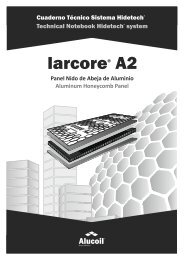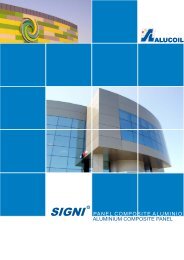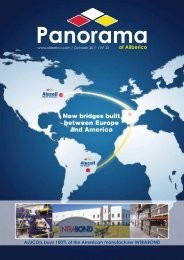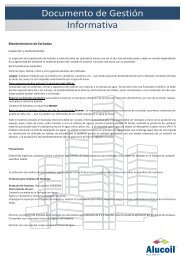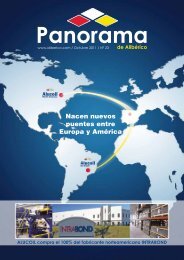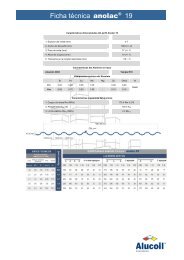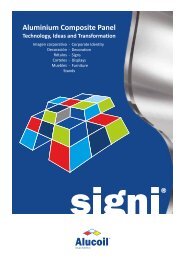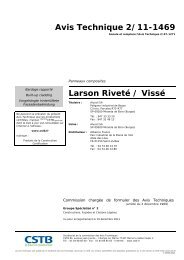Ficha Técnica de Producto - Alucoil
Ficha Técnica de Producto - Alucoil
Ficha Técnica de Producto - Alucoil
Create successful ePaper yourself
Turn your PDF publications into a flip-book with our unique Google optimized e-Paper software.
Paneles Aluminio Nido <strong>de</strong> Abeja<br />
Fachadas - Construcción<br />
Mediante un proceso industrial en continuo, <strong>Alucoil</strong>® fabrica su panel estructural larcore® A2,<br />
contribuyendo en sus distintas aplicaciones a mejorar en términos <strong>de</strong> Rigi<strong>de</strong>z, Ligereza, No Combustibilidad,<br />
No Toxicidad, Reciclabilidad, Aislamiento y Eficiencia Energética.<br />
2.39 1.68<br />
3.13<br />
2.19<br />
10.78<br />
7.55<br />
19.85<br />
13.90<br />
31.67<br />
22.17<br />
45.79<br />
32.74<br />
Acabados: PVdF y HQ Polyester<br />
Cualquier Color Carta RAL<br />
RIGIDEZ LIGEREZA RECICLABLE<br />
PLANICIDAD RESISTENCIA FUEGO ANCHO 2000mm
<strong>Ficha</strong> técnica larcore ® A2 10 mm<br />
Características dimensionales <strong>de</strong>l panel<br />
1.1. Espesor total (b) (mm) 10<br />
1.2. Espesor <strong>de</strong>l metal (e 1) (mm) 1,0<br />
1.3. Espesor <strong>de</strong>l metal (e 2) (mm) 0,7<br />
1.4. Peso (kg/m 2 ) 5,59<br />
1.5. Ancho estándar (mm) 1000 – 1250 – 1500 – 2000<br />
1.6. Longitud mínima / máxima (mm) 2000 / 9000<br />
1.7. Tolerancia espesor (mm) ± 0,2<br />
1.8. Tolerancia ancho (mm) - 0 / + 2<br />
1.9. Tolerancia longitud (mm) - 0 / + 6<br />
1.10. Núcleo nido <strong>de</strong> abeja <strong>de</strong> aluminio<br />
1.11. Tamaño <strong>de</strong> celda (C) (in)(mm) a) 1/4’’ – 6,35 mm b) 3/8” – 9,52 mm<br />
Características mecánicas <strong>de</strong>l panel<br />
2.1. Momento <strong>de</strong> inercia (J) (cm 4 /m) DIN 53293 3,86<br />
2.2. Rigi<strong>de</strong>z (EJ) (KNcm 2 /m) DIN 53293 27.017<br />
2.3. Módulo <strong>de</strong> resistencia (W) (cm 3 /m) DIN 53293 6,86<br />
2.4. Reducción sonora (Rw) (dB) EN ISO 717-1 20<br />
2.5. Aislamiento acústico (R A) (dBA) EN ISO 717-1 20,3<br />
2.6. Resistencia térmica (R) (m 2 K/W) UNE 92-202-89:1989 0,016<br />
2.7. Conductividad térmica (λ) (W/mK) UNE 92-202-<br />
89:1989<br />
0,632<br />
2.8. Dilatación <strong>de</strong>l aluminio (mm/m) 2,3 ∆ 100ºC<br />
2.9. Estabilidad respecto a la temperatura (ºC) -40 / + 80<br />
Características <strong>de</strong> las capas <strong>de</strong> aluminio<br />
3.1. Aleación <strong>de</strong>l aluminio UNE EN 573-3 5005<br />
3.2. Carga <strong>de</strong> rotura (N/mm 2 ) UNE EN 485-2 130 < Rm < 165<br />
3.3. Límite elástico (N/mm 2 ) UNE EN 485-2 90 < Rp 0,2 < 155<br />
3.4. Alargamiento (A) (%) UNE EN 485-2 > 7<br />
3.5. Módulo elástico (E) (N/mm 2 ) 70.000<br />
Características <strong>de</strong>l núcleo <strong>de</strong> aluminio<br />
4.1. Aleación <strong>de</strong>l aluminio UNE EN 573-3 3003<br />
4.2. Resistencia a la compresión (MPa) DIN 53291 a) 2,20 b) 2,00<br />
4.3. Densidad <strong>de</strong>l núcleo (kg/m 3 ) a) 56 b) 54<br />
4.4. Imprimación <strong>de</strong> protección Si<br />
Clasificación al fuego<br />
5.1. Sector construcción: EN 13501-1 A2-s2,d0<br />
5.2. Sector ferrocarril: UNE 23721-27<br />
M1<br />
NF P 92-501 – NF F 16-101<br />
M1 – F1<br />
5.3. Sector naval: International Maritime Organization (IMO) IMO FTPC Part 5 surface flammability<br />
IMO FTPC Part 2 smoke <strong>de</strong>nsity and toxicity<br />
IMO – RESOLUTION A.653 (16)<br />
MED – US Coast Guard
<strong>Ficha</strong> técnica larcore ® A2 14 mm<br />
Características dimensionales <strong>de</strong>l panel<br />
1.1. Espesor total (b) (mm) 14<br />
1.2. Espesor <strong>de</strong>l metal (e 1) (mm) 0,7<br />
1.3. Espesor <strong>de</strong>l metal (e 2) (mm) 0,7<br />
1.4. Peso (kg/m 2 ) 5,01<br />
1.5. Ancho estándar (mm) 1000 – 1250 – 1500 – 2000<br />
1.6. Longitud mínima / máxima (mm) 2000 / 9000<br />
1.7. Tolerancia espesor (mm) ± 0,2<br />
1.8. Tolerancia ancho (mm) - 0 / + 2<br />
1.9. Tolerancia longitud (mm) - 0 / + 6<br />
1.10. Núcleo nido <strong>de</strong> abeja <strong>de</strong> aluminio<br />
1.11. Tamaño <strong>de</strong> celda (C) (in)(mm) a) 1/4’’ – 6,35 mm b) 3/8” – 9,52 mm<br />
Características mecánicas <strong>de</strong>l panel<br />
2.1. Momento <strong>de</strong> inercia (J) (cm 4 /m) DIN 53293 7,09<br />
2.2. Rigi<strong>de</strong>z (EJ) (KNcm 2 /m) DIN 53293 49.652<br />
2.3. Módulo <strong>de</strong> resistencia (W) (cm 3 /m) DIN 53293 10,13<br />
2.4. Reducción sonora (Rw) (dB) EN ISO 717-1 21<br />
2.5. Aislamiento acústico (R A) (dBA) EN ISO 717-1 21,0<br />
2.6. Resistencia térmica (R) (m 2 K/W) UNE 92-202-89:1989 0,020<br />
2.7. Conductividad térmica (λ) (W/mK) UNE 92-202-<br />
89:1989<br />
0,6974<br />
2.8. Dilatación <strong>de</strong>l aluminio (mm/m) 2,3 ∆ 100ºC<br />
2.9. Estabilidad respecto a la temperatura (ºC) -40 / + 80<br />
Características <strong>de</strong> las capas <strong>de</strong> aluminio<br />
3.1. Aleación <strong>de</strong>l aluminio UNE EN 573-3 5005<br />
3.2. Carga <strong>de</strong> rotura (N/mm 2 ) UNE EN 485-2 130 < Rm < 165<br />
3.3. Límite elástico (N/mm 2 ) UNE EN 485-2 90 < Rp 0,2 < 155<br />
3.4. Alargamiento (A) (%) UNE EN 485-2 > 7<br />
3.5. Módulo elástico (E) (N/mm 2 ) 70.000<br />
Características <strong>de</strong>l núcleo <strong>de</strong> aluminio<br />
4.1. Aleación <strong>de</strong>l aluminio UNE EN 573-3 3003<br />
4.2. Resistencia a la compresión (MPa) DIN 53291 a) 2,20 b) 2,00<br />
4.3. Densidad <strong>de</strong>l núcleo (kg/m 3 ) a) 56 b) 54<br />
4.4. Imprimación <strong>de</strong> protección Si<br />
Clasificación al fuego<br />
5.1. Sector construcción: EN 13501-1 A2-s2,d0<br />
5.2. Sector ferrocarril: UNE 23721-27<br />
M1<br />
NF P 92-501 – NF F 16-101<br />
M1 – F1<br />
5.3. Sector naval: International Maritime Organization (IMO) IMO FTPC Part 5 surface flammability<br />
IMO FTPC Part 2 smoke <strong>de</strong>nsity and toxicity<br />
IMO – RESOLUTION A.653 (16)<br />
MED – US Coast Guard
<strong>Ficha</strong> técnica larcore ® A2 20 mm<br />
Características dimensionales <strong>de</strong>l panel<br />
1.1. Espesor total (b) (mm) 20<br />
1.2. Espesor <strong>de</strong>l metal (e 1) (mm) 1,0<br />
1.3. Espesor <strong>de</strong>l metal (e 2) (mm) 1,0<br />
1.4. Peso (kg/m 2 ) 6,91<br />
1.5. Ancho estándar (mm) 1000 – 1250 – 1500 – 2000<br />
1.6. Longitud mínima / máxima (mm) 2000 / 9000<br />
1.7. Tolerancia espesor (mm) ± 0,2<br />
1.8. Tolerancia ancho (mm) - 0 / + 2<br />
1.9. Tolerancia longitud (mm) - 0 / + 6<br />
1.10. Núcleo nido <strong>de</strong> abeja <strong>de</strong> aluminio<br />
1.11. Tamaño <strong>de</strong> celda (C) (in)(mm) a) 1/4’’ – 6,35 mm b) 3/8” – 9,52 mm<br />
Características mecánicas <strong>de</strong>l panel<br />
2.1. Momento <strong>de</strong> inercia (J) (cm 4 /m) DIN 53293 19,91<br />
2.2. Rigi<strong>de</strong>z (EJ) (KNcm 2 /m) DIN 53293 139.300<br />
2.3. Módulo <strong>de</strong> resistencia (W) (cm 3 /m) DIN 53293 19,91<br />
2.4. Reducción sonora (Rw) (dB) EN ISO 717-1 23<br />
2.5. Aislamiento acústico (R A) (dBA) EN ISO 717-1 23,0<br />
2.6. Resistencia térmica (R) (m 2 K/W) UNE 92-202-89:1989 0,023<br />
2.7. Conductividad térmica (λ) (W/mK) UNE 92-202-<br />
89:1989<br />
0,8627<br />
2.8. Dilatación <strong>de</strong>l aluminio (mm/m) 2,3 ∆ 100ºC<br />
2.9. Estabilidad respecto a la temperatura (ºC) -40 / + 80<br />
Características <strong>de</strong> las capas <strong>de</strong> aluminio<br />
3.1. Aleación <strong>de</strong>l aluminio UNE EN 573-3 5005<br />
3.2. Carga <strong>de</strong> rotura (N/mm 2 ) UNE EN 485-2 130 < Rm < 165<br />
3.3. Límite elástico (N/mm 2 ) UNE EN 485-2 90 < Rp 0,2 < 155<br />
3.4. Alargamiento (A) (%) UNE EN 485-2 > 7<br />
3.5. Módulo elástico (E) (N/mm 2 ) 70.000<br />
Características <strong>de</strong>l núcleo <strong>de</strong> aluminio<br />
4.1. Aleación <strong>de</strong>l aluminio UNE EN 573-3 3003<br />
4.2. Resistencia a la compresión (MPa) DIN 53291 a) 2,20 b) 2,00<br />
4.3. Densidad <strong>de</strong>l núcleo (kg/m 3 ) a) 56 b) 54<br />
4.4. Imprimación <strong>de</strong> protección Si<br />
Clasificación al fuego<br />
5.1. Sector construcción: EN 13501-1 A2-s2,d0<br />
5.2. Sector ferrocarril: UNE 23721-27<br />
M1<br />
NF P 92-501 – NF F 16-101<br />
M1 – F1<br />
5.3. Sector naval: International Maritime Organization (IMO) IMO FTPC Part 5 surface flammability<br />
IMO FTPC Part 2 smoke <strong>de</strong>nsity and toxicity<br />
IMO – RESOLUTION A.653 (16)<br />
MED – US Coast Guard



